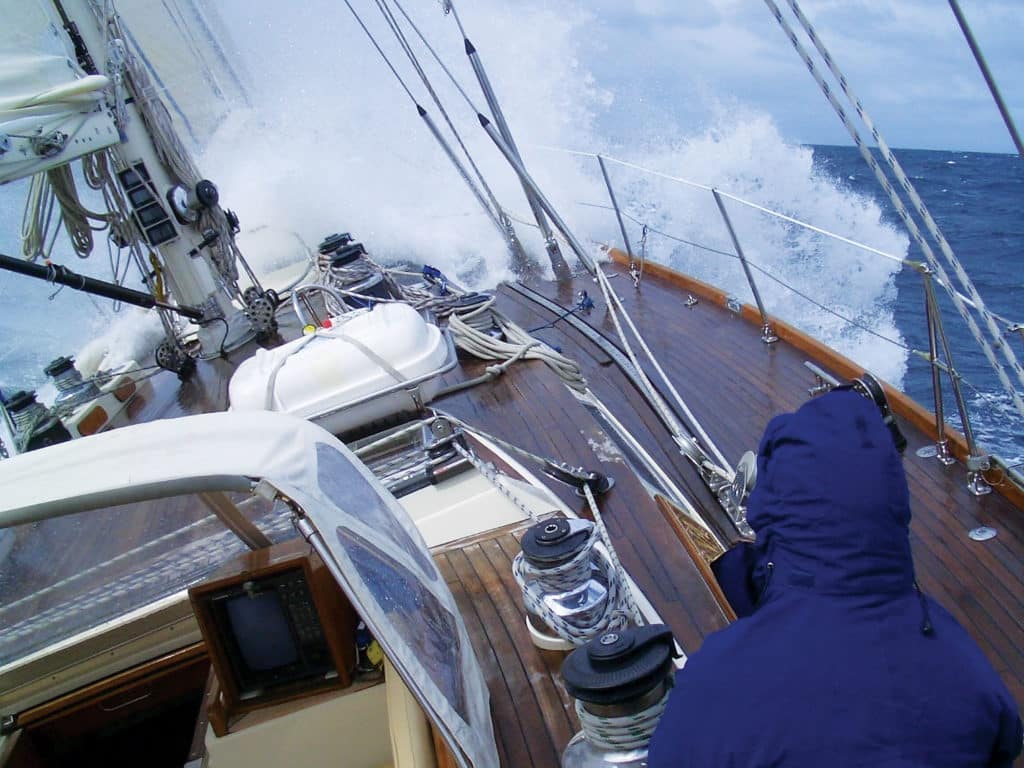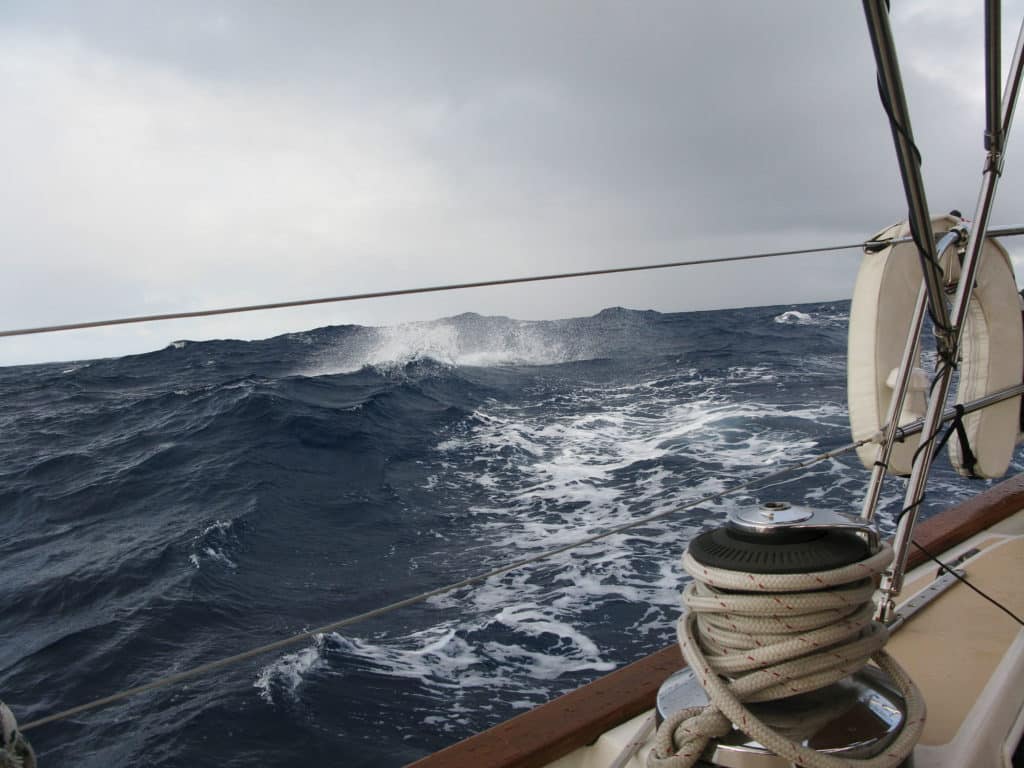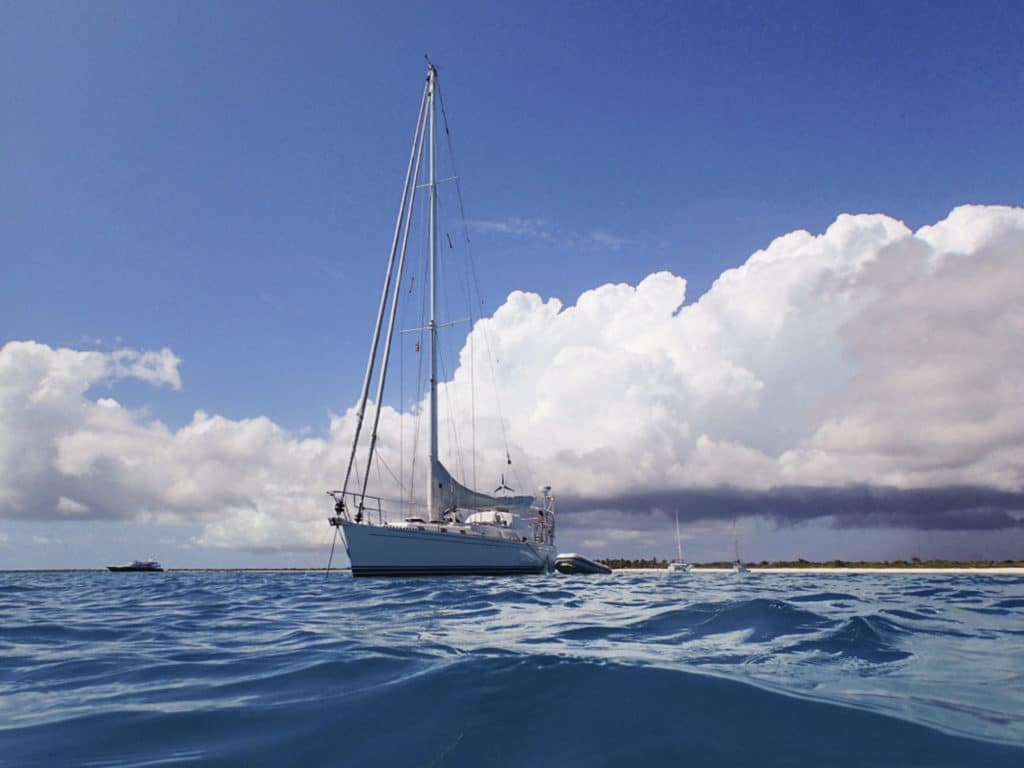
Storm tactics can be roughly defined as the ways to handle a storm once you’re in it. There are several proven choices, all of which intend to keep either the bow or stern pointing toward the waves. No one tactic will work best for all sailboats in all conditions. As skipper, it will be up to you to consider the best approach for your vessel, procure the right equipment, and practice with it before it’s needed.
Here we look at some active storm options that might work when conditions are still manageable and you want to actively control and steer the boat. Crew fatigue is a serious consideration when using active tactics.
Forereaching
Although not often mentioned as a tactic, it can be highly effective for combating brief squalls or moderate-duration storms. Here’s how to set up your boat for forereaching: Roll the jib away (especially if you have a large roller-furler genoa set); reef the main down to the second or third reef position; and sail on a closehauled course, concentrating on keeping the boat flat. It will be a comfortable ride, everyone will be relatively happy, and you will be making 2 to 3 knots on a close reach. Check your course over ground because increased leeway will cause your track to be much lower. This is a possibly useful tactic to claw off a lee shore. Note that not all boats will be at ease forereaching, so you’d better experiment with it ahead of time. Catamarans in particular will lurch and demonstrate much-increased leeway.
Motorsailing
Sometimes it’s necessary from a time or safety perspective to stow the jib and fire up the iron genny instead. Motorsailing lets you point high and make progress to windward. Motoring with no sails will not work well (or at all, in some cases), particularly in big seas, but a reefed mainsail will provide lateral stability and extra power. Trim the main, head up high enough to control your angle of heel, set the autopilot, and keep a lookout. Fuel consumption makes this a short-term option.
Here’s a tip: Make sure cooling water is pumping through the engine. On some sailboats, the water intake lifts out of the water when heeled. A further difficulty is that the pitching boat might stir sediment off the bottom of the fuel tank, which can, in turn, clog the fuel filter.
Running off and drogues
Sailing under storm jib and a deeply reefed mainsail or storm trysail provides the most control. If you don’t have storm sails, a reefed jib will give you the power to steer and control your boat in the waves. The boat must be steered actively to maintain control because no autopilot will be able to do this.
If excessive speed is a problem and steering becomes difficult, towing a drogue will slow the boat. A retrieval line should be set from the head of the drogue for when it is time to bring it back on board. If you don’t have a drogue, trailing warps might help slow the boat.
In a storm of longer duration, or when conditions become otherwise unmanageable, the situation might call for a skipper to consider passive storm tactics. When you are exhausted and you just want to quiet down the boat and maybe get some rest, there are other boathandling options available, depending on the sea state and the equipment you have onboard.
Heave to
Heaving to can be an excellent heavy-weather tactic, though some boats fare better than others. Wouldn’t it be great if during a heavy-weather episode you could just slow everything way down? Imagine a short respite with a reduced amount of motion from the relentless pitching and pounding. A chance to regroup, make a meal, or check over the boat. Well, you can.
Heaving to allows you to “park” in open water. Hove-to trim has the jib trimmed aback (that is, to the wrong side), the reefed main eased, and the helm lashed down to leeward. The easiest way to do this is to trim the jib sheet hard and then tack the boat, leaving the sheet in place. Trimmed this way, the jib pushes the bow down. As the bow turns off the wind, the main fills and the boat moves forward. With the helm lashed down, the rudder turns the boat toward the wind. As the main goes soft, the jib once again takes over, pushing the bow down. The main refills, and the rudder pushes the bow into the wind again.
RELATED: Safety at Sea: Mental Preparations Contribute to Positive Outcomes
Achieving this balance will require some fine-tuning, depending on the wind strength, your boat design and the sails you have. You might, for example, need to furl the jib most of the way in to match the wind strength. Trimming the main will ensure that the bow is at an angle to the waves, ideally pointing 40 to 60 degrees off. Modern fin-keeled boats do not heave to as well as more-traditional full-keel designs.
When hove to, the boat won’t actually stop. It will lie, as noted, about 40 to 60 degrees off the wind, sailing at 1 or 2 knots, and making leeway (sliding to leeward). Beware of chafe. When hove to, the jib’s clew or sheet will be up against the shroud and might experience wear damage. Monitor this regularly, and change the position of the sheet occasionally. You might not want to heave to for an extended time.
Deploying a sea anchor
A sea anchor is a small parachute deployed on a line off the bow. A sea anchor helps keep the bow pointed up into the waves so the boat won’t end up beam to the seas. Light displacement boats will pitch violently in high seas, and chafe and damage might occur to the bow, so setting up a bridle and leading it aft through a snatch block will allow the boat to lie at an angle to the waves, providing a more comfortable ride. A big concern when using a sea anchor is the load on the rudder as the waves slam the boat backward. Chafe on the sea-anchor bridle is another big factor, so the bridle must be tended regularly.

Remember, if you and your vessel are caught out in heavy-weather conditions, as a skipper, you must show leadership by setting an example, watching over your crew, offering relief and help to those who need it, and giving encouragement. Remember too, discomfort and fear can lead to fatigue, diminished performance, and poor decision-making. Don’t compromise the safety of the boat and crew to escape discomfort.
Few people get to experience the full fury of a storm. Advances in weather forecasting, routing and communications greatly improve your odds of avoiding heavy weather at sea, but you’re likely to experience it at some point, so think ahead of time about the tactics and tools available to keep your crew and vessel safe.

Heavy weather might not be pleasant, but it is certainly memorable, and it will make you a better sailor. Take the time to marvel at the forces of nature; realize that the boat is stronger than you think.
Happy sailing, and may all your storms be little ones!
This story is an edited excerpt from the American Sailing Association’s recently released manual, Advanced Cruising & Seamanship, by Bill Gladstone, produced in collaboration with North U. It has been edited for design purposes and style. You can find out more at asa.com.








